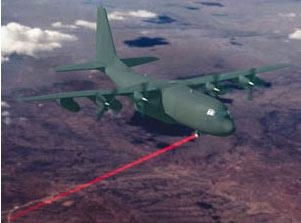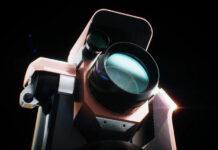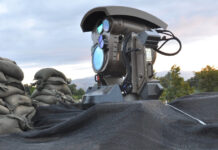The Airborne tactical Laser is a Special Operations Command (SOCOM) sponsored Advanced Concept Technology demonstration (ACTD) program, designed to demonstrate the use of high power tactical lasers from an airborne platform.
 Under the program, a chemical oxygen-iodine laser (COIL) will be installed on a modified C-130H transport aircraft, simulating a future AC-130 laser equipped gunship. The airborne tactical laser will be able to destroy, damage or disable targets at tactical ranges with little to no collateral damage, supporting missions on the battlefield and in urban operations. The laser will be able to place a 10-centimeter-wide beam with enough energy to melt and slice through a metal target from a distance of 15 kilometers. ATL is expected to produce scaleable effects, meaning the weapon operator will be able to select the degree and nature of the damage done to a target by choosing a specific aimpoint and laser shot duration. For example, targeting the fuel tank of a vehicle could result in total destruction of the vehicle, while targeting a tire might result in the vehicle stopping without injury to the driver.
Under the program, a chemical oxygen-iodine laser (COIL) will be installed on a modified C-130H transport aircraft, simulating a future AC-130 laser equipped gunship. The airborne tactical laser will be able to destroy, damage or disable targets at tactical ranges with little to no collateral damage, supporting missions on the battlefield and in urban operations. The laser will be able to place a 10-centimeter-wide beam with enough energy to melt and slice through a metal target from a distance of 15 kilometers. ATL is expected to produce scaleable effects, meaning the weapon operator will be able to select the degree and nature of the damage done to a target by choosing a specific aimpoint and laser shot duration. For example, targeting the fuel tank of a vehicle could result in total destruction of the vehicle, while targeting a tire might result in the vehicle stopping without injury to the driver.
The program is led by Boeing, which is assisted by an industry team including L-3 Communications/Brashear, which made the laser turret, and HYTEC, Inc., which made various structural elements of the weapon system. Boeing began flight testing of a surrogate solid-state laser in October 2006. The aircraft used a surrogate solid-state “low-power” laser for search and track of ground targets. The system utilizes the hardware designed for the high power chemical laser, which includes the beam director and optical control bench, controlling and directing the laser beam to its target; weapon system consoles, which will display high-resolution imagery and enable the tracking of targets; and sensors.
The high power chemical laser destined for the program was also tested for the first time on Sept 21st, the ground, generating the “first light” of the high-energy chemical laser in ground tests. In december 2007, the high power module was installed on the aircraft and by 2008 it is scheduled to fire in-flight at mission-representative ground targets to demonstrate the military utility of high energy-lasers. The test team will fire the laser through a rotating turret that extends through an existing 50-inch-diameter hole in the aircraft’s belly. Future potential ATL platforms could be the C-130 and MV-22 tilt-rotor aircraft.
















